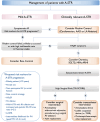Atrial secondary tricuspid regurgitation: pathophysiology, definition, diagnosis, and treatment
- PMID: 38441886
- PMCID: PMC11095052
- DOI: 10.1093/eurheartj/ehae088
Atrial secondary tricuspid regurgitation: pathophysiology, definition, diagnosis, and treatment
Abstract
Atrial secondary tricuspid regurgitation (A-STR) is a distinct phenotype of secondary tricuspid regurgitation with predominant dilation of the right atrium and normal right and left ventricular function. Atrial secondary tricuspid regurgitation occurs most commonly in elderly women with atrial fibrillation and in heart failure with preserved ejection fraction in sinus rhythm. In A-STR, the main mechanism of leaflet malcoaptation is related to the presence of a significant dilation of the tricuspid annulus secondary to right atrial enlargement. In addition, there is an insufficient adaptive growth of tricuspid valve leaflets that become unable to cover the enlarged annular area. As opposed to the ventricular phenotype, in A-STR, the tricuspid valve leaflet tethering is typically trivial. The A-STR phenotype accounts for 10%-15% of clinically relevant tricuspid regurgitation and has better outcomes compared with the more prevalent ventricular phenotype. Recent data suggest that patients with A-STR may benefit from more aggressive rhythm control and timely valve interventions. However, little is mentioned in current guidelines on how to identify, evaluate, and manage these patients due to the lack of consistent evidence and variable definitions of this entity in recent investigations. This interdisciplinary expert opinion document focusing on A-STR is intended to help physicians understand this complex and rapidly evolving topic by reviewing its distinct pathophysiology, diagnosis, and multi-modality imaging characteristics. It first defines A-STR by proposing specific quantitative criteria for defining the atrial phenotype and for discriminating it from the ventricular phenotype, in order to facilitate standardization and consistency in research.
Keywords: Atrial fibrillation; Atrial functional tricuspid regurgitation; Secondary tricuspid regurgitation; Transcatheter interventions; Tricuspid regurgitation; Tricuspid valve.
© The Author(s) 2024. Published by Oxford University Press on behalf of the European Society of Cardiology.
Figures








References
MeSH terms
LinkOut - more resources
Full Text Sources
Medical
Research Materials

